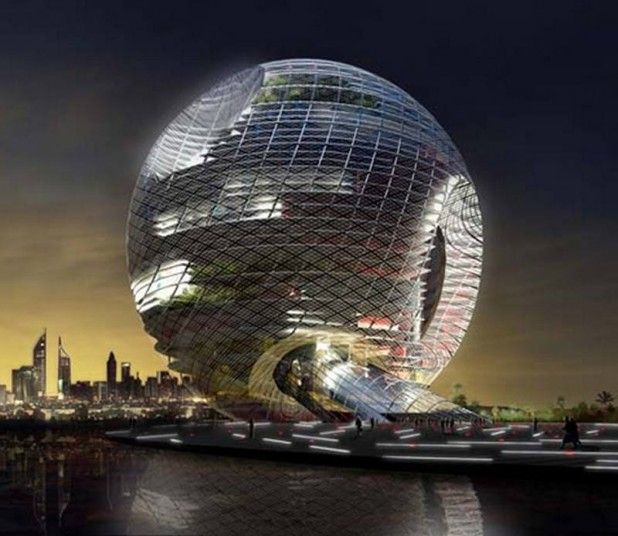Modernism
Modernism is a global architecture and design movement that emerged in the 1920s as a response to accelerated industrialization and social changes. Pursuing order and universals in architecture, modernism utilized new materials and advanced technology and rejected old, traditional, historical ideas and styles, and ornamentation. Modernism emphasized function, simplicity, and rationality, and created new forms of expression with a new aesthetic.
This new aesthetic resulted in modern buildings characterized by clean lines, simple geometric shapes, pure cubic forms, ribbon windows, flat roofs, and functional, flexible open interior spaces with plain exposed structures that were considered appropriate for all nations and cultures.
History of ModernismThe rise of modernism in architecture is between the 1920s and 1950s. However, its origins go back to the Enlightenment and expansions to the high-tech. Thus, its history can be divided into three periods, as early, modern, and late, at which the most famous mottos of architecture were coined. Let's first look at what we can call the Early Modernism (1650-1914) and look at it through the centuries.
Eighteenth Century Modernism was influenced by the Enlightenment (Age of Reason), which brought the Industrial Revolution. This influence was based on rationalism, a foundational term for the Enlightenment, which goes back to Descartes who saw the world as a machine, functioning by mechanical laws. Modernism took rationalism as accuracy in designing and adaptation of architectural conditions to industry.
The modernist motto, ''a house is a machine for living in,'' stated by Le Corbusier in 1921, refers to a building having the purity of form of a well-designed machine and an architecture that is functional as machine parts. This ''machine aesthetic'' that originates from Descartes defines one of the central concepts of modernism.
Late Nineteenth Century Early modernist Adolf Loos had an impact on modernism, too. His essay published in 1908 created the slogan, ''ornament is a crime.'' With crime, Loos meant the waste of money, labor, and materials, thus the economics of building. For him, as modern man appreciated simplicity, ornament had no meaning, place, or value within modern society.
This aesthetic purism with pragmatic reasoning was reflected in modernism as simplicity and elimination of ornament. Echoing Loos in their works, modernist architects regarded ornamentation as a symbol of the past, traditional, historical styles and rejected it in favor of clean structures with plain, unornamented surfaces.
This aesthetic purism with pragmatic reasoning was reflected in modernism as simplicity and elimination of ornament. Echoing Loos in their works, modernist architects regarded ornamentation as a symbol of the past, traditional, historical styles and rejected it in favor of clean structures with plain, unornamented surfaces.
Early Twentieth CenturyFather of modernism, Louis Sullivan coined another famous motto, ''form follows function,'' in 1918. Modernist architects like Mies van der Rohe were highly influenced by Sullivan's slogan expressing the purpose of the building by emphasizing function and design from inside out. In modernism, priority was given to function, and function was the basis of form.
Now, let's look at the true Modernism period that lasted form 1917-1950 and the different styles that defined certain periods of time.
Bauhaus Modernism (1917-1933)Modernism in architecture grew from the Bauhaus, a German architecture and design school established in 1919 by Walter Gropius along with Mies, Marcel Breuer, Wassily Kandinsky, and Paul Klee. Bauhaus combined art with technology, crafts with industrial production to revitalize design for everyday life.
Now, let's look at the true Modernism period that lasted form 1917-1950 and the different styles that defined certain periods of time.
Bauhaus Modernism (1917-1933)Modernism in architecture grew from the Bauhaus, a German architecture and design school established in 1919 by Walter Gropius along with Mies, Marcel Breuer, Wassily Kandinsky, and Paul Klee. Bauhaus combined art with technology, crafts with industrial production to revitalize design for everyday life.
Knights of Columbus Building (New Haven, Connecticut)
Knights of Columbus Building (New Haven, Connecticut) Knights of Columbus Tower or The Knights' Tower, the building was designed by Kevin Roche John Dinkeloo and Associates and finished in 1969. This 23-story modern style reinforced concrete building, at 320 feet (98 meters) tall, is the third-tallest building in the city's skyline.
The Knights' Tower serves as the international headquarters for the Knights of Columbus and is home to the Supreme Council. |













